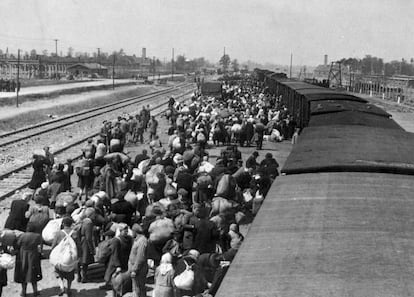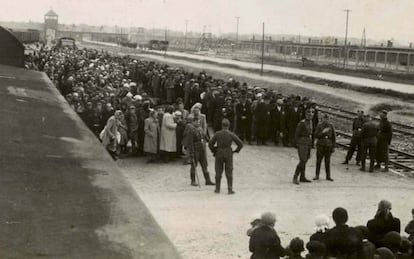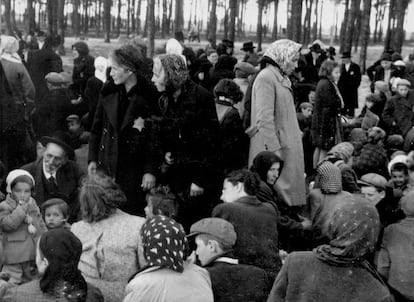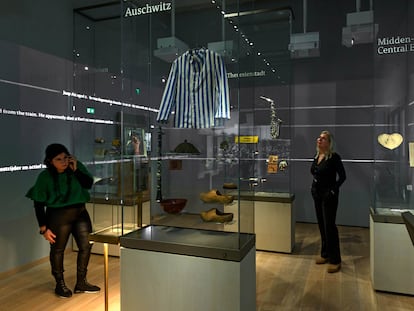The boom of books with Auschwitz in the title: The publishing industry uses the Holocaust as a commercial hook
Novels named after the Nazi death camp proliferate despite accusations of trivializing the Shoah


In recent years the following books have arrived in bookstores around the world: The Librarian of Auschwitz (by Spanish author Antonio Iturbe, it was written respectfully and factually and published in 2012, before Auschwitz became a commercial fad); The Auschwitz Photographer; Auschwitz: A Doctor’s Eyewitness Account; The Children’s Block: A Novel Based on the True Story of an Auschwitz Survivor; The Dressmakers of Auschwitz; Auschwitz Lullaby; The Pharmacist of Auschwitz; Surviving the Angel of Death: The True Story of a Mengele Twin in Auschwitz; The Magician of Auschwitz; The Tattooist of Auschwitz (a great international success); The Violinist of Auschwitz; The Daughter of Auschwitz; The Boy Who Followed His Father into Auschwitz; The Happiest Man on Earth: The Beautiful Life of an Auschwitz Survivor; A Delayed Life: The True Story of the Librarian of Auschwitz; The Volunteer: The True Story of the Resistance Hero Who Infiltrated Auschwitz; The Girl Who Escaped from Auschwitz; Ballerina of Auschwitz… Between 2010 and 2024, there’s been a boom of books with Auschwitz in the title: this list is a selection that does not include rigorous scientific essays, such as the ones by Laurence Rees and Sybille Steinbacher, or classics by camp survivors, such as Primo Levi’s Auschwitz Trilogy.
The vast majority are inspired by true stories that occurred in the German concentration and extermination camp, where the Nazis murdered more than a million people, mainly Jews. But they are fictionalized by taking certain liberties with the facts. It is not a parody. All the titles exist. Then there are the internationally bestselling novels like The Boy in the Striped Pajamas, where the camp’s name does not appear in the title, although they take place in that setting.
How the Shoah and Nazi horrors can be depicted — and whether fiction is a legitimate way to do so — has been problematic since the end of World War II. But the current proliferation of books comes at an important and defining moment: unfortunately, there are fewer and fewer survivors left to tell what happened and the living memory of a unique tragedy is disappearing with them. There are virtually no perpetrators still alive. First-person accounts of the horror will soon give way to an era without witnesses. Those who did not experience it — and who will not be able to speak to those who lived through the camps and ghettos — will bear full responsibility for telling the story. What is happening in the bookstores does not augur well.

Wanda Witek-Malicka of the Auschwitz Museum Research Center — located in present-day Poland and built in Nazi-occupied territory as the Third Reich’s largest death camp — is emphatic: “Auschwitz and the Holocaust as symbols have undoubtedly, and unfortunately, become commodities for sale.” The expert, who conducts research at the Auschwitz Museum, adds that “books with barbed wire and striped prisoner outfits on the cover are sold at discount stores, gas stations and supermarkets, and on social media they are depicted in pastel-colored photographs as perfect vacation reads. Popular novels about Auschwitz, essentially Holocaust fiction, teach nothing new; they simply recycle the same set of stereotypes and symbols. The commercialization of Auschwitz and the popularization of a trivialized, grossly simplified and romanticized Holocaust narrative (intended for sale as an easily digestible version of history), create a whole new educational reality that professionals working in places of memory must confront.”
In the past, the Auschwitz Memorial — now a UNESCO Heritage Site — had already spoken out about the historical errors in some of these novels that had become international bestsellers and might replace the authentic facts in collective memory. The aim was to make it very clear that whoever read these books was not receiving reliable information about the Holocaust. Of The Tattooist of Auschwitz, the Memorial posted the following message on then-Twitter in 2018 (where it currently has 1.5 million followers): “Due to the number of factual errors The Tattooist of Auschwitz cannot be recommended as a valuable position for those who wish to understand the history of the camp. The book is an impression about Auschwitz inspired by authentic events, almost without any value as a document.”
Due to the number of factual errors "The Tattooist of Auschwitz" cannot be recommended as a valuable position for those who wish to understand the history of the camp. The book is an impression about Auschwitz inspired by authentic events, almost without any value as a document. https://t.co/76j88CJyDF
— Auschwitz Memorial (@AuschwitzMuseum) November 20, 2018
In recent weeks, a controversy has broken out over Fermina Cañaveras’ novel El barracón de las mujeres [The women’s hut]. The book has prompted protests from the relatives of survivors of the Ravensbrück camp, who accuse the author of manipulating reality to achieve publishing success through morbid curiosity. The current controversy reflects a problem that has never been resolved: how to tell the story of the Holocaust and what liberties a narrator can take with the reality of Nazism. Cañaveras’ book was previously published two years ago by a smaller publishing house in Spain, Molinos y Gigantes, under a very explicit title, Putas de campo [Camp whores].
Her work deals with the sexual slavery to which hundreds of inmates were subjected in the only Nazi concentration camp for women, who were transferred to other camps to become prostitutes. It could be argued that this book’s success helps to inform about a little-known aspect of terror under the Nazis. But one could also contend — as the survivors’ families do — that it is pure morbid curiosity, and that the women’s suffering is being used to sell books that invent stories far removed from reality. A similar controversy arose in 1978 when the Holocaust miniseries premiered: it was accused of trivializing the Shoah and turning it into a soap opera.
“Untrue, offensive, cheap. As a TV production, the film is an insult to those who perished and to those who survived. In spite of its name, this ‘docu‐drama’ is not about what some of us remember as the Holocaust,” Elie Wiesel, Nobel Peace Prize winner, Auschwitz survivor and the author of seminal works on the Holocaust such as Night, wrote when it premiered. French filmmaker Claude Lanzmann, who was then working on Shoah, the 10-hour documentary considered the most important film on the Holocaust, was even more emphatic: “This is fiction. That is to say a fundamental lie, a moral crime, a murder of memory.” Nevertheless, the miniseries had an enormous impact and was instrumental in spreading awareness of the Jewish genocide in Germany. It helped bring a crime that had been relatively hidden out of oblivion. At the time, Variety magazine reported a survey that claimed that 70% of German 14-19-year-olds said they learned more about the Holocaust from the miniseries than they did in school.

Nearly 30 years ago, in November 1993, Steven Spielberg’s Schindler’s List, the film adaptation of Australian Thomas Kennelly’s book, premiered. This movie about the Holocaust has perhaps had the greatest global impact. Again, the debate resurfaced. Some critics objected to the suspenseful scene in the showers (for a few minutes, viewers do not know whether gas or water will come out). Others criticized the decision to tell the story of a good German in the midst of an atrocity in which all strata of German society collaborated. But the film’s visual force prevailed resoundingly.
Even so, many voices spoke out against the film, including Lanzmann. “When I saw Schindler’s List, I felt the same way I did with Holocaust. Fiction is a transgression, I am deeply convinced that there is a ban on depiction. Transgressing or trivializing, in this case they are identical. The series or the Hollywood film, they transgress because they trivialize, and thus they remove the Holocaust’s unique character,” the filmmaker wrote in Le Monde, where he also recognized the artistic merits of the film and its director. Years later, however, Lanzmann spoke out in favor of Hungarian director László Nemes’s Son of Saul, which he saw at Cannes in 2015: “László Nemes has invented something. And he was clever enough not to try to show the Holocaust. He knew he could not and should not.” In 1997, Roberto Begnini’s Life is Beautiful received both fiery praise and tremendous criticism for turning the Holocaust into a kind of fable; the film was a success with audiences and won an Academy Award.
But the phenomenon of recent years in which many authors and publishers have engaged — where Auschwitz has become a trademark — is unparalleled.
But not all fiction about Auschwitz are the same, and they do not all respond to a commercial impulse. One recent example is Jonathan Glazer’s film The Zone of Interest, where only the sound of the camp is heard; that makes this story about the banality of evil, which won the Oscar for Best Foreign Language Film, even more terrifying. Another example is Die Passagierin [The passenger], the subtle and brutal opera by Mieczyslaw Weinberg, who survived Nazism and Stalinism. These two works are fictional stories that subject viewers to enormous tension, forcing them to reflect on the abysses of evil and to look at themselves in a repulsive mirror; they situate viewers in a place where the frontiers of humanity are blurred.
The deep discomfort provoked by Cañaveras’ work and the proliferation of fiction with Auschwitz in the title — of varying artistic and documentary value — not only has to do with their distance from reality, but also with the danger of trivializing a unique tragedy, as Lanzmann warned. Elie Wiesel spent his life fighting so that the Holocaust would not be forgotten: “To forget would be absolute injustice in the same way that Auschwitz was the absolute crime,” he testified in the trial against Klaus Barbie, the butcher of Lyon. We must remember not only for the victims, but for its lessons for the present: trying to understand Nazism also means understanding the mechanisms of evil in a society.
In an interview with this newspaper in 1992, Wiesel was very concerned about the war in Bosnia-Herzegovina, in which the Serbs committed genocide against the Bosnians. He had just visited Sarejevo during its siege. “We have no right to compare; but we also have no right to be silent,” he said. The line between diffusion and trivialization is a fine one. But right now the problem is not whether Auschwitz has been forgotten — as it was in Germany until the 1960s — but whether the Nazi horror can become a vulgar commodity, with nothing but commercial value in the present.
Sign up for our weekly newsletter to get more English-language news coverage from EL PAÍS USA Edition
Tu suscripción se está usando en otro dispositivo
¿Quieres añadir otro usuario a tu suscripción?
Si continúas leyendo en este dispositivo, no se podrá leer en el otro.
FlechaTu suscripción se está usando en otro dispositivo y solo puedes acceder a EL PAÍS desde un dispositivo a la vez.
Si quieres compartir tu cuenta, cambia tu suscripción a la modalidad Premium, así podrás añadir otro usuario. Cada uno accederá con su propia cuenta de email, lo que os permitirá personalizar vuestra experiencia en EL PAÍS.
¿Tienes una suscripción de empresa? Accede aquí para contratar más cuentas.
En el caso de no saber quién está usando tu cuenta, te recomendamos cambiar tu contraseña aquí.
Si decides continuar compartiendo tu cuenta, este mensaje se mostrará en tu dispositivo y en el de la otra persona que está usando tu cuenta de forma indefinida, afectando a tu experiencia de lectura. Puedes consultar aquí los términos y condiciones de la suscripción digital.
More information
Archived In
Últimas noticias
Maduro pleads not guilty before the federal court in New York: ‘I am still the president of Venezuela’
A new test can detect Alzheimer’s from a finger prick
UN team enters Sudanese city of El Fasher after paramilitary massacre: ‘It’s like a ghost town’
A recipe for resistance: Indigenous peoples politicize their struggles from the kitchen
Most viewed
- Gilles Lipovetsky: ‘If you want to live better and fall in love, take Prozac, don’t look to philosophy’
- Alain Aspect, Nobel laureate in physics: ‘Einstein was so smart that he would have had to recognize quantum entanglement’
- Alvin Hellerstein, a 92-year-old judge appointed by Bill Clinton, to preside over Maduro’s trial in New York
- Why oil has been at the center of Venezuela-US conflicts for decades
- Maduro’s downfall puts China’s relationship with Venezuela to the test










































